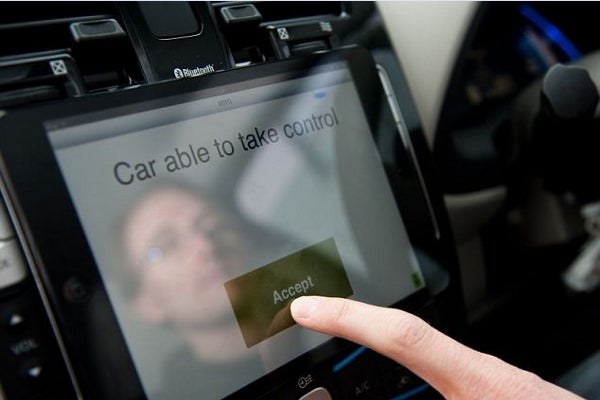Self-driving car given test runs on UK roads

Oxford University scientists have developed a self-driving car that can drive itself along familiar roads using lasers and small cameras to memorise routes.
Demoed at an Oxford University event, the self-driving car could take over laborious routine journeys like the school run or the commute to work by utilising a system of on-board lasers, cameras and computers to safely drive itself.
Able to stop for pedestrians and negotiate traffic jams, the system has been developed by a team at Oxford University who believe the navigation system could be seen in mainstream markets within 15 years.
The system, created by The Oxford RobotCar UK Project, has been installed in a customised Nissan Leaf, with the user experience provided by an Apple iPad to guide users through the checks needed to initiate the self-driving functions of the car. The technology can take the wheel at the touch of the iPad screen, whilst tapping the brake pedal will return control to the driver.
The on-board cameras and lasers act as the car’s eyes when being driven manually, mapping a 3D model of the roads and surrounding, storing them in the computer stored in the car’s boot for future self-driving capability, accurate to within a few centimetres. When on autodrive, the car uses the lasers to detect any “blockages” in the road to avoid obstacles or traffic collisions.
Although the RobotCar project has yet to reach public UK roads, the modified Nissan Leaf can be found driving round the private roads within Oxford University’s Begbroke Science Park.
“We’re working with the Department of Transport to get some miles on the road in the UK,” said Professor Newman from the University of Oxford’s Department of Engineering Science, speaking to the BBC. “[Begbroke Science Park is] not like a racetrack – it’s a light industrial site with roads and road markings. Crucial for us, it can show our navigation and control system working.”
Google has been testing its own driverless cars in California, currently pushing for road law changes so it may test the vehicles on real-life roads. However, the Google technology relies on GPS technology to map its routes, which is often outdated and unreliable.
The Google car also has a spinning laser to scan surroundings mounted on the vehicle’s roof, which is very expensive. Eventually the system from Oxford University should cost as little as £100 and would be available for any vehicle, but it currently costs around £5,000, still far cheaper than other prototypes around.
“Well if you look at it, we don’t need a 3D laser spinning on the roof that’s really expensive – so that’s one thing straight away. I think our car has a lower profile,” said Newman.
From the exterior, the Nissan leaf looks like any other model – aside from The Oxford RobotCar UK branding – as the system is fitted with discreetly around the car’s existing design.
Would you be interested in low-cost driverless technology for your vehicle? Or, do you think this technology is something that should be staying in Sci-Fi movies? Give us your thoughts via the Trusted Reviews Facebook and Twitter pages or the comments section below.

